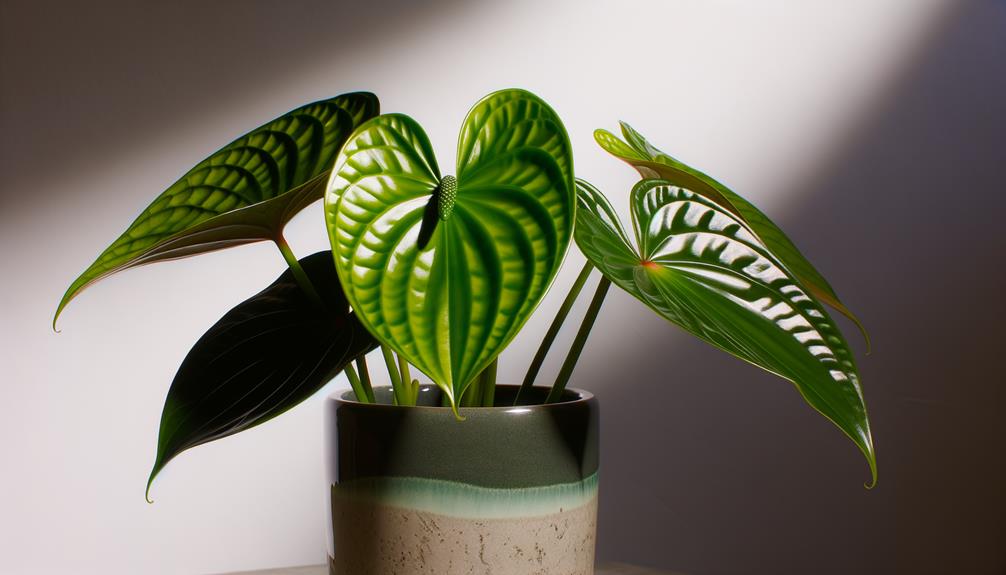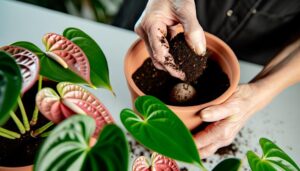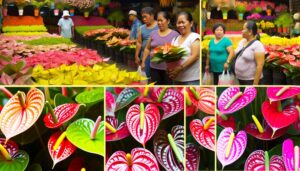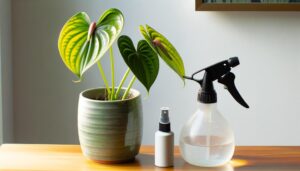Ultimate Guide to Anthurium Decipiens Care
To care for Anthurium decipiens, place it in bright, indirect light, like near an east or north-facing window. Water with dechlorinated or distilled water when the top 1-2 inches of soil are dry.
Maintain humidity at 70-80% using a humidifier or misting the foliage. Use a well-draining soil mix with perlite, orchid bark, and sphagnum moss.
Keep temperatures between 65°F to 80°F, and avoid abrupt changes. Check regularly for pests and diseases, treating promptly with neem oil or insecticidal soap.
Propagate by division or stem cuttings. When overwatering, look for yellowing leaves.
Discover more essential tips for thriving Anthurium decipiens.

Key Takeaways
- Place Anthurium Decipiens in bright, indirect light and avoid direct sunlight.
- Water when the top 1-2 inches of soil are dry using dechlorinated or distilled water.
- Maintain 70-80% relative humidity using a humidifier or water-filled tray.
- Use a well-draining soil mix of perlite, orchid bark, and sphagnum moss.
- Regularly inspect and promptly treat pests and fungal infections.
Ideal Lighting Conditions
Anthurium decipiens flourishes in bright, indirect light, resembling the dappled sunlight found under a forest canopy. Position your plant near an east or north-facing window, where it can receive filtered sunlight. You can use sheer curtains to diffuse direct sunlight, preventing leaf scorch.
Avoid placing it in low-light conditions, as insufficient light can impede photosynthesis, leading to poor growth and reduced vigor. Artificial light sources like fluorescent or LED grow lights can supplement natural light, especially during shorter days. Aim for a light intensity of 10,000 to 20,000 lux (1,000 to 2,000 foot-candles) for best growth.
Rotate the plant periodically to guarantee even light distribution. Monitoring light levels with a light meter can help maintain ideal conditions for your Anthurium decipiens.
Watering Techniques
To maintain ideal hydration for your Anthurium decipiens, water the plant thoroughly when the top 1-2 inches of soil feel dry to the touch. Use dechlorinated or distilled water at room temperature to prevent mineral buildup in the soil. Make sure you water until it drains through the pot's drainage holes, promoting healthy root oxygenation.
Avoid waterlogging, as Anthurium roots (epiphytic in nature) are prone to rot. To mimic their natural humid environment, maintain a relative humidity of 60-80%. You can utilize a humidity tray or mist the leaves periodically.
Monitor for signs of overwatering, such as yellowing leaves or root rot, and adjust your watering schedule accordingly. Proper hydration guarantees robust growth and vibrant spathes.
Soil Preferences
When selecting soil for Anthurium decipiens, prioritize a well-draining, aerated mix to prevent root rot. Utilize components like perlite, orchid bark, and sphagnum moss to achieve the ideal soil composition.
Maintain the medium's moisture without becoming waterlogged, promoting peak root health.
Ideal Soil Composition
Choosing the appropriate soil composition for Anthurium decipiens involves creating a well-draining mixture that mimics its natural epiphytic habitat, typically a blend of orchid bark, perlite, and peat moss. Orchid bark (Pinus radiata) provides structural support and aeration. Perlite (expanded volcanic glass) improves drainage and prevents compaction. Peat moss (Sphagnum spp.) retains moisture while maintaining a lightweight quality.
Here's a detailed breakdown:
| Component | Function |
|---|---|
| Orchid Bark | Structural support, aeration |
| Perlite | Improved drainage, prevents compaction |
| Peat Moss | Moisture retention, lightweight mix |
Incorporate these elements in equal portions to sustain ideal conditions. This specific blend ensures your Anthurium decipiens roots receive sufficient oxygen while preventing waterlogging, fostering robust growth and vitality.
Drainage and Aeration
Promoting proper drainage and aeration is crucial for the health of Anthurium decipiens, as it prevents root rot and supports excellent nutrient absorption. You'll want a soil mix that's well-draining yet retains some moisture. Combine equal parts of orchid bark, perlite, and peat moss.
Orchid bark provides structural support and aeration, while perlite enhances drainage. Peat moss holds moisture without becoming waterlogged. Make sure your pot has drainage holes to allow excess water to escape. You can also add horticultural charcoal to enhance air circulation around the roots.
Regularly check the soil's moisture level; it should be damp but not waterlogged. Maintaining this balance ensures your Anthurium decipiens thrives in optimal growing conditions.
Temperature Requirements
Maintaining Anthurium decipiens at a stable temperature range between 65°F and 80°F is important for best growth and health. Aim for consistent ambient temperatures; fluctuations can stress the plant.
Avoid positioning it near drafts, heating vents, or air conditioning units, as abrupt changes in temperature can hinder its physiological processes. If you're growing Anthurium decipiens indoors, consider using a digital thermometer to monitor the environment closely. Make sure nighttime temperatures don't fall below 60°F, as colder conditions can impede metabolic functions.
During summer months, shield the plant from excessive heat by situating it in a location with indirect sunlight. Maintaining ideal thermal conditions promotes robust foliage and encourages Anthurium decipiens to produce its characteristic inflorescences effectively.
Humidity Levels
Humidity levels play a crucial role in the health and growth of Anthurium decipiens, necessitating a consistent humidity range of 70-80% to mimic its native tropical environment.
Utilize a hygrometer to monitor ambient moisture levels. If humidity dips below the optimal range, employ a humidifier to increase air moisture.
Placing the plant on a tray filled with water and pebbles can also elevate humidity through evaporation. Avoid placing Anthurium decipiens near heating vents or drafty windows, as fluctuating conditions can stress the plant.
Regularly misting the foliage with distilled water can help maintain leaf turgor and overall plant vitality. Guarantee adequate air circulation to prevent fungal infections, which thrive in overly stagnant, humid conditions.
Fertilizing Needs
To support the vigorous growth of Anthurium decipiens, apply a balanced, water-soluble fertilizer diluted to half strength every four to six weeks during the active growing season. This guarantees the plant receives essential nutrients without the risk of over-fertilization. Use a fertilizer with an N-P-K ratio of 20-20-20 or 10-10-10 for best results.
Monitor the plant's foliage for signs of nutrient deficiencies, such as yellowing leaves or stunted growth. Always flush the soil with water periodically to prevent salt buildup, which can harm the root system.
- Enhance vibrant leaf color ��
- Stimulate robust root development ��
- Foster lush, healthy foliage ��
- Maximize growth potential ��
- Prevent nutrient deficiencies ��
Pruning and Maintenance
To sustain Anthurium decipiens, regularly trim to encourage healthy growth and prevent disease. Make sure to eliminate dead or yellowing foliage using sterilized, sharp pruning shears to avoid infection.
Keep your tools clean and sharp to guarantee precise cuts and minimize stress on the plant.
Regular Trimming Benefits
Regular pruning of Anthurium decipiens promotes healthier growth by removing dead or diseased leaves, which can prevent the spread of pathogens and improve overall plant vigor. Use sterilized pruning shears to make clean cuts close to the base. Make sure you trim away any yellowing or brown leaves regularly. This encourages the plant to direct its energy toward new, healthy growth.
Benefits of regular pruning include:
- Enhanced Aesthetics: Your Anthurium will look lush and vibrant.
- Disease Prevention: Reduced risk of fungal and bacterial infections.
- Improved Air Circulation: Better airflow around leaves, reducing humidity-related issues.
- Resource Allocation: Energy is diverted to flourishing parts of the plant.
- Growth Stimulation: Encourages the development of new leaves and flowers.
Follow these steps to maintain a thriving Anthurium decipiens.
Removing Dead Foliage
When removing dead foliage from your Anthurium decipiens, use sterilized pruning shears to make precise cuts close to the stem to prevent disease.
Always target necrotic leaves and those with chlorosis signs. Position the shears at a 45-degree angle to facilitate best healing and minimize pathogen entry.
Avoid tearing the foliage, as this can lead to unnecessary stress on the plant. Disinfect your tools between cuts to reduce the risk of cross-contamination.
Regularly inspect your Anthurium decipiens for any signs of decay or pest infestation. By promptly removing compromised foliage, you enhance the plant's overall strength and aesthetic appeal.
Follow these steps meticulously to maintain a healthy, thriving Anthurium decipiens.
Tool Maintenance Tips
Taking care of your pruning shears and other tools maintains they stay effective and safe for use on your Anthurium decipiens.
Clean your tools after each use to avoid spreading pathogens. Use isopropyl alcohol or a 10% bleach solution to sterilize blades, guaranteeing diseases like Xanthomonas campestris are kept at bay.
Sharpen your shears regularly to make clean cuts, preventing damage to plant tissue.
- Sterilize after each use: Keep your Anthurium healthy.
- Sharpen blades frequently: Assures precise, clean cuts.
- Lubricate moving parts: Prevents rust and ensures smooth operation.
- Store tools properly: Dry, cool places extend lifespan.
- Inspect for damage: Replace or repair promptly to avoid mishaps.
Proper maintenance not only prolongs the life of your tools but safeguards your Anthurium decipiens thrives.
Repotting Guidelines
Every 2-3 years, you should repot your Anthurium decipiens to promote maximum growth and root health. Begin by selecting a pot that is 1-2 inches larger in diameter than the current one, guaranteeing ample drainage. Use an epiphytic mix containing orchid bark, sphagnum moss, and perlite for peak aeration. Gently remove the plant, shake off old soil, and trim damaged roots. Place the plant in the new pot, fill in with fresh mix, and water thoroughly.
| Step | Details |
|---|---|
| Pot Size | 1-2 inches larger, with drainage holes |
| Soil Mix | Orchid bark, sphagnum moss, perlite |
| Root Care | Remove old soil, trim damaged roots, replant firmly |
Following these steps guarantees a healthy, thriving Anthurium decipiens.
Pest and Disease Management
Effective pest and disease management for Anthurium decipiens involves vigilant monitoring for common issues like spider mites, mealybugs, and root rot caused by Phytophthora species. Inspect your plant regularly for signs of infestation, such as webbing or white fluffy masses.
Use insecticidal soap or neem oil to control pests like spider mites (Tetranychidae) and mealybugs (Pseudococcidae). For root rot, maintain well-draining soil and avoid overwatering. Remove any affected roots and treat with a fungicide containing metalaxyl or fosetyl-Al.
- Spot tiny webs? Act immediately!
- Fluffy masses? Mealybugs are attacking!
- Yellowing leaves? Check for root rot.
- Regular inspections? Your best defense.
- Appropriate treatments? Essential for plant health!
Taking these steps can keep your Anthurium thriving.
Propagation Methods
How can you propagate Anthurium decipiens successfully?
Start with division or stem cuttings. For division, carefully remove the plant from its pot, gently separating the root ball into smaller sections, making sure each section has roots and foliage. Plant each division in a well-draining mix, ideally a combination of orchid bark, perlite, and peat moss.
For stem cuttings, select a healthy stem with at least one node. Using sterilized scissors, cut below the node, and dip the cut end in rooting hormone. Place the cutting in moist sphagnum moss and maintain high humidity. Covering it with a plastic bag can help. Guarantee temperatures remain between 20-25°C (68-77°F). Within a few weeks, roots should form, allowing you to transplant.
Common Issues
Anthurium decipiens often faces issues like root decay, leaf discoloration, and pest invasions, which can have a significant impact on plant health. To prevent root decay, make sure the substrate has excellent drainage and avoid overwatering.
Leaf discoloration, typically caused by nutrient deficiencies or improper light, can be mitigated by balanced fertilization and correct light exposure.
Pest invasions, such as spider mites and aphids, require vigilant inspection and prompt treatment with insecticidal soap or neem oil.
Common issues include:
- Root decay: Overwatering and inadequate drainage
- Leaf discoloration: Nutrient deficiencies, improper light
- Pest invasions: Spider mites, aphids
- Fungal infections: Powdery mildew, leaf spots
- Temperature stress: Cold drafts, extreme heat
Addressing these problems guarantees your Anthurium decipiens thrives.
Conclusion
Caring for Anthurium decipiens is like tending to a delicate symphony; each element must harmonize perfectly. With the right light, precise watering, ideal soil, and controlled temperature and humidity, your plant will flourish.
Regular repotting, vigilant pest management, and proper propagation guarantee its longevity. By mastering these elements, you're not just growing a plant—you're cultivating a living masterpiece.
Keep your Anthurium decipiens in balance, and it will reward you with its striking beauty.






